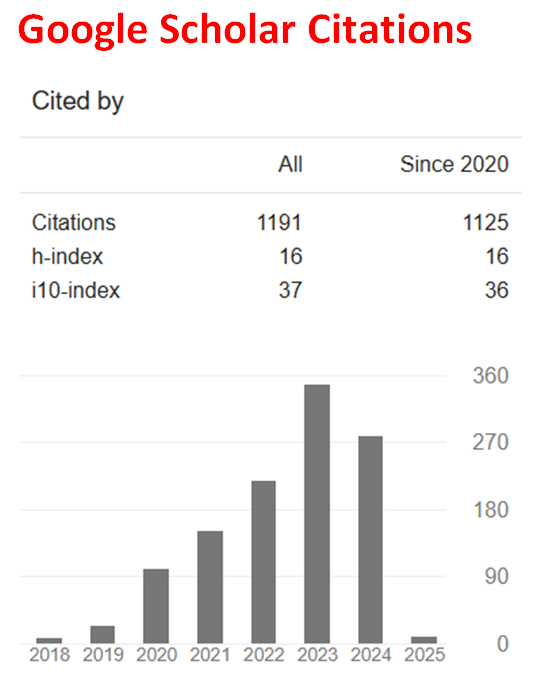Modeling and Forecasting Under-Five Mortality Rate in Nigeria using Auto-Regressive Integrated Moving Average Approach
Abstract
Nigeria’s efforts aimed at reducing avoidable child deaths have been met with gradual and sustained progress. Despite the decline in childhood mortality in Nigeria in the last two decades, its prevalence still remain high in comparison to the global standard of mortality for children under the age of five which stands at 25 deaths per 1000 live births. Knowledge of the chances of Nigeria achieving this goal for childhood mortality will aid proper interventions needed to reduce the occurrence.
Therefore, this paper employed the Auto-Regressive Integrated Moving Average (ARIMA) model for time series analysis to make forecast of under-five mortality in Nigeria up to 2030 using data obtained from the United Nation’s Inter Agency Group for Childhood Mortality Estimate (UN-IGME).
The ARIMA (2, 1, 1) model predicted a reduction of up to 37.3% by 2030 at 95% confidence interval. Results from the study also showed that a reduction of over 300% in under-five mortality is required for Nigeria to be able to achieve the SDG goal for under-five mortality.
Downloads
References
G. W. Adetoro and E. O. Amoo, A statistical analysis of child mortality: Evidence from Nigeria, Journal of Demography and Social Statistics 1 (2014), 110-120.
O. Aremu, S. Lawoko and K. Dalal, Neighbourhood socioeconomic disadvantage, individual wealth status and patterns of delivery care utilization in Nigeria: a multilevel discrete choice analysis, Int. Journal of Women’s Health 3 (2011), 167-174. https://doi.org/10.2147/IJWH.S21783
G. E. P. Box and G. M. Jenkins, Time Series Analysis, Forecasting and Control, Holden-Day, Oakland, CA, 1976.
V. T. Adekanmbi, G. A. Kayode and O. A. Uthman, Individual and contextual factors associated with childhood stunting in Nigeria: a multilevel analysis, Maternal Child Nutr. 9(2) (2013), 244-259. https://doi.org/10.1111/j.1740-8709.2011.00361.x
J. Fox, Public health, poor relief and improving urban child mortality outcomes in the decade prior to the New Deal, MPIDR Working Paper WP-2011-005, 2012. https://doi.org/10.4054/MPIDR-WP-2011-005
G. Mesike and N. Mojekwu, Environmental determinants of child mortality in Nigeria, Journal of Sustainable Development 5(1) (2012). https://doi.org/10.5539/jsd.v5n1p65
O. M. Morakinyo and A. F Fagbamigbe, Neonatal, infant and under-five mortalities in Nigeria: an examination of trends and drivers (2003-2013), PLoS ONE 12(8) (2017), e0182990. https://doi.org/10.1371/journal.pone.0182990
National Population Commission and ICF Macro, Nigerian Demographic and Health Survey 2008, National Population Commission, Federal Republic of Nigeria, Abuja, Nigeria and ICF Macro Calverton, Maryland, USA, 2009.
E. P. Opare, Time Series Models for the Decrease in Under-Five Mortality, Thesis submitted to the Department of Mathematics, Kwame Nkrumah University of Science and Technology, Ghana, 2014.
A. M. Starrs, Safe motherhood initiative: 20 years and counting, Lancet (London England) 368(9542) (2006), 1130-1132. https://doi.org/10.1016/S0140-6736(06)69385-9
Levels and Trends in Child Mortality - United Nations Inter-Agency Group for Child Mortality Estimates UN-IGME, Report 2019.
A. Usman, M. A. Sulaiman, I. Abubakar, Trends of neonatal mortality in Nigeria from 1990 to 2017 using time series analysis, J. Appl. Sci. Environ. Manage. 23(5) (2019), 865-869. https://doi.org/10.4314/jasem.v23i5.15
World Health Organisation, Child Mortality: Millennium Development Goal (MDG) 4, The Partner for Maternal and New Born Birth, World Health Organisation, September 2011. http://www.who.int/pmnch/media/press_materials/fs/fs_mdg4_childmortality/en/
S. Yaya, M. Ekholuenetale, G. Tudeme, S. Vaibhav, G. Bishwajit and B. Kadio, Prevalence and determinants of childhood mortality in Nigeria, BMC Public Health 17 (2017), 485. https://doi.org/10.1186/s12889-017-4420-7

This work is licensed under a Creative Commons Attribution 4.0 International License.
.jpg)

